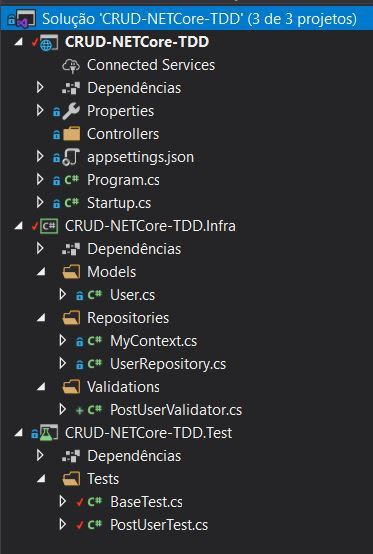The complete project can be found here: https://github.com/lucianopereira86/CRUD-NetCore-TDD
Technologies
- Visual Studio 2019
- .NET Core 3.1.0
- xUnit 2.4.0
- Microsoft.EntityFrameworkCore 3.1.0
- FluentValidation 8.6.0
Post User • Theory
Red Step • Age
Let's do a Theory for the "Age" attribute.
[Theory]
[InlineData(0, 102)]
[InlineData(-1, 102)]
[InlineData(33, 102)]
public void Theory_PostUser_Age(int Age, int ErrorCode)
{
var user = new User
{
Age = Age
};
CheckError(new PostUserValidator(), ErrorCode, user);
}
If you run the tests, there will error for all the values because we have not implemented the validation for the age yet. It must be greater than zero.
Green Step • Age
Inside the PostUserValidators constructor, add the following lines:
public PostUserValidator()
{
RuleFor(x => x.Name)
.Cascade(CascadeMode.StopOnFirstFailure)
.NotEmpty()
.WithErrorCode("100")
.MaximumLength(20)
.WithErrorCode("101");
RuleFor(x => x.Age)
.Cascade(CascadeMode.StopOnFirstFailure)
.GreaterThan(0)
.WithErrorCode("102");
}
Run the tests again and this will be the result:
Only the valid value (33) has not returned any error, so our tests are working correctly again!
Post User • Fact II
Refactor Step II
There is no need for another Theory for the "PostUserTest" but another Fact is required to validate the data. Rename the "Fact_PostUser" method to "Fact_PostUser_NoValidation" and create another one:
[Fact]
public void Fact_PostUser()
{
// EXAMPLE
var user = new User(0, "LUCIANO PEREIRA", 33, true);
var val = new PostUserValidator().Validate(user);
// ASSERT
Assert.True(val.IsValid);
if (val.IsValid)
{
// REPOSITORY
user = new UserRepository(ctx).Post(user);
// ASSERT
Assert.Equal(1, user.Id);
}
}
This time we are using the "Assert" class to ensure that the validation will be true before accessing the repository. Run the test again.
This must be your project so far:
Coming soon...
The PUT method will be the next to receive tests, repository and validation.






Top comments (7)
I think I'm missing something? Shouldn't we want the green step to actually go "full green". Shouldn't there not be any failing tests? Earlier in part 5, you just kind of say to "comment out of the test", is this something you are planning on addressing later?
Thanks for the contact.
Probably you are talking about "Theory".
In fact, the way I work is to give multiple values to a "Theory" and expected at least one of them to be red.
Why?
Because this way I can make sure that the validation won't fail if a valid value be used.
If you do not agree with this practice, just comment the "InlineData" that would return a red test result.
Have I answered your question?
Yes, that is the part I was talking about. I don't understand why you would want a failing test case to "stick around". IMO, this would cause you to need to review the tests every time to confirm you didn't actually break something. Image having thousands and thousands of test cases with several developers. I feel you would need to consistently be checking which ones are failing to know if you broke something or if that is "one of the ones that supposed to be there".
Just my 2 cents
Unfortunately, I've had a bad experience in the past that made me paranoic about the possibility of a valid value being considered invalid. Since then, I've tested it as well in my Theories. I know I am breaking the a TDD rule, but it was only my vision as developer.
I will edit my posts to let very clear that this approach was my decision.
Thanks anyway.
What about making the test "invertible", by adding a bool parameter which will swap failure and success around if set to true? That way the test would still exist and be green
good idea.
I've made something similar but using enum.
to make it clear, have separate SUCCESS and FAIL test is a good thing, like:
best to do one test per fact, e.g. test the 20 char limit, test if there's at least a special char in the password and have multiple values for that test that should pass.
same way give multiple values for the test where the failing condition is tested, e.g.:
fact_password_without_special_chars_should_be_rejected